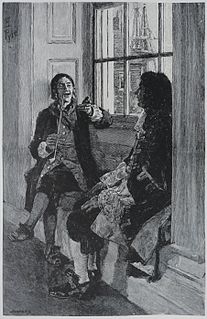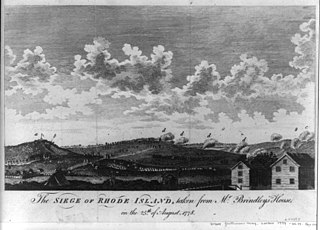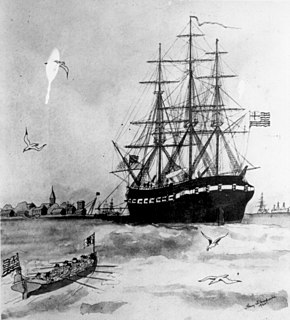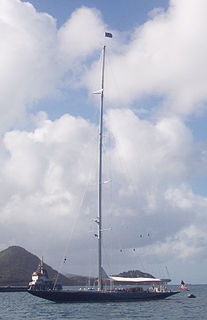Related Research Articles

HMS Endeavour, also known as HM Bark Endeavour, was a British Royal Navy research vessel that Lieutenant James Cook commanded to Australia and New Zealand on his first voyage of discovery from 1768 to 1771.

USS Mitscher (DL-2/DDG-35), named for Admiral Marc "Pete" Mitscher USN (1887–1947), was the lead ship of her class of destroyer of the United States Navy.

A lateen or latin-rig is a triangular sail set on a long yard mounted at an angle on the mast, and running in a fore-and-aft direction.

USS Providence was a sloop-of-war in the Continental Navy, originally chartered by the Rhode Island General Assembly as Katy. The ship took part in a number of campaigns during the first half of the American Revolutionary War before being destroyed by her own crew in 1779 to prevent her falling into the hands of the British after the failed Penobscot Expedition.

Thomas Tew, also known as the Rhode Island Pirate, was a 17th-century English privateer-turned pirate. He embarked on two major pirate voyages and met a bloody death on the second, and he pioneered the route which became known as the Pirate Round. Many other infamous pirates followed in his path, including Henry Every and William Kidd.

A Bermuda rig, Bermudian rig, or Marconi rig is a configuration of mast and rigging for a type of sailboat and is the typical configuration for most modern sailboats. This configuration was developed in Bermuda in the 17th century; the term Marconi, a reference to the inventor of the radio, Guglielmo Marconi, became associated with this configuration in the early 20th century because the wires that stabilize the mast of a Bermuda rig reminded observers of the wires on early radio masts.

Sail components include the features that define a sail's shape and function, plus its constituent parts from which it is manufactured. A sail may be classified in a variety of ways, including by its orientation to the vessel and its shape,. Sails are typically constructed out of flexible material that is shaped by various means, while in use, to offer an appropriate airfoil, according to the strength and apparent direction of the wind. A variety of features and fittings allow the sail to be attached to lines and spars.
USS Java was a wooden-hulled, sailing frigate in the United States Navy, bearing 44 guns. She was named for the American victory over HMS Java off the coast of Brazil on 29 December 1812, captured by the Constitution under the command of Captain William Bainbridge. HMS Java had suffered severe damage during the engagement and being far from home port was ordered burned.

USS Isherwood (DD-284) was a Clemson-class destroyer in service with the United States Navy from 1919 to 1930. She was scrapped in 1931.

USS Charles H. Roan (DD-853) was a Gearing-class destroyer of the United States Navy. The ship was named after Charles Howard Roan, a United States Marine who lost his life in action on the island of Palau during World War II.

USS Hugh Purvis (DD-709) was an Allen M. Sumner-class destroyer in service with the United States Navy from 1945 to 1972. She was then transferred to Turkey and served until 1993 as TCG Zafer (D356). The ship was scrapped in 1994.

USS Smalley (DD-565), a Fletcher-class destroyer, was the first ship of the United States Navy to be named for Ensign Anthony A. Smalley (1836–1894).

The Battle of Rhode Island took place on August 29, 1778. Continental Army and militia forces under the command of General John Sullivan had been besieging the British forces in Newport, Rhode Island, which is situated on Aquidneck Island, but they had finally abandoned their siege and were withdrawing to the northern part of the island. The British forces then sortied, supported by recently arrived Royal Navy ships, and they attacked the retreating Americans. The battle ended inconclusively, but the Continental forces withdrew to the mainland and left Aquidneck Island in British hands.

The junk rig, also known as the Chinese lugsail or sampan rig, is a type of sail rig in which rigid members, called battens, span the full width of the sail and extend the sail forward of the mast.
A mast-aft rig is a sailboat sail-plan that uses a single mast set in the aft half of the hull. The mast supports fore-sails that may consist of a single jib, multiple staysails, or a crab claw sail. The mainsail is either small or completely absent. Mast-aft rigs are uncommon, but are found on a few custom, and production sailboats.

The Battle of Block Island was a naval skirmish which took place in the waters off Rhode Island during the American Revolutionary War. The Continental Navy under the command of Commodore Esek Hopkins was returning from a successful raid on Nassau when it encountered HMS Glasgow, a Royal Navy dispatch boat.

Endeavour is a J-class yacht built for the 1934 America's Cup by Camper and Nicholson in Gosport, England. She was built for Thomas Sopwith who used his aviation design expertise to ensure the yacht was the most advanced of its day with a steel hull and mast. She was 130-foot (40 m) and launched in 1934 and won many races in her first season including against the J's Velsheda and Shamrock V. She failed in her America's Cup challenge against the American defender Rainbow but came closer to lifting the cup than any other until Australia II succeeded in 1983.

John Rousmaniere is an American writer and author of 30 historical. technical, and instructional books on sailing, yachting history, New York history, business history, and the histories of clubs, businesses, and other organizations. An authority on seamanship and boating safety, he has conducted tests of equipment and sailing skills, and led or participated in fact-finding inquiries into boating accidents. He has been presented with several awards for his writing and his contributions to boating safety and seamanship.

A sail is a tensile structure—made from fabric or other membrane materials—that uses wind power to propel sailing craft, including sailing ships, sailboats, windsurfers, ice boats, and even sail-powered land vehicles. Sails may be made from a combination of woven materials—including canvas or polyester cloth, laminated membranes or bonded filaments—usually in a three- or four-sided shape.
Robert Colley was an English pirate and privateer active near Newfoundland and the Indian Ocean.
References
- ↑ Rousmaniere, John (2014-01-07). The Annapolis Book of Seamanship: Fourth Edition. Simon and Schuster. p. 111. ISBN 9781451650242.
- ↑ Neal, Tom (January 1995). There's the rub. Cruising World. Newport, Rhode Island. p. 25.
- ↑ Textor, Ken (1995). The New Book of Sail Trim. Sheridan House, Inc. p. 185. ISBN 9780924486814.
- ↑ Leonard, Beth A. (September 2007). Sew it yourself. Cruising World. Newport, Rhode Island. p. 140.
- ↑ Jasper, Aaron (December 1992). Sail repair and jury-rigging at sea. Cruising World. Newport, Rhode Island. p. 75.